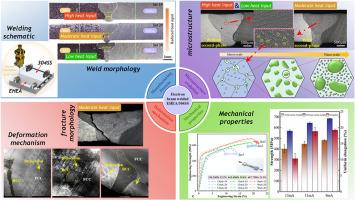Microstructure evolution and mechanical properties of electron beam welded AlCoCrFeNi2.1 eutectic high-entropy alloy/304 stainless steel joints
IF 4.8
2区 材料科学
Q2 CHEMISTRY, PHYSICAL
引用次数: 0
Abstract
The AlCoCrFeNi2.1 eutectic high-entropy alloy has emerged as a promising candidate for advanced structural applications due to its exceptional strength and thermal stability. In contrast, 304 stainless steel is widely employed in industrial settings owing to its low cost, excellent corrosion resistance, and superior processability. In this study, dissimilar welding of AlCoCrFeNi2.1 and 304 stainless steel was successfully performed using electron beam welding, and the influence of various welding parameters on joint microstructure and mechanical properties was systematically investigated. Microstructural analysis revealed that under moderate heat input conditions, second-phase particles precipitated within the weld, with Cr-rich nanoparticles embedded inside them, ultimately forming a dual-phase structure comprising FCC and B2 phases. In contrast, at high or low heat inputs, the weld region primarily exhibited a single-phase disordered FCC solid solution, with no second-phase formation. Mechanical testing showed that the joint produced under low heat input achieved a maximum tensile strength of 687 MPa, corresponding to 91 % of the 304SS base metal, along with a post-fracture elongation of 21.5 %. The enhanced strength is primarily attributed to grain refinement, Al-induced crystalline defects, and the triaxial stress constraint effect arising from the narrow nail-shaped weld geometry. These findings provide critical insights for the design of high-quality weld joints between AlCoCrFeNi2.1and Fe-based structural materials.

电子束焊接AlCoCrFeNi2.1共晶高熵合金/304不锈钢接头的组织演变及力学性能
由于其优异的强度和热稳定性,AlCoCrFeNi2.1共晶高熵合金已成为先进结构应用的有希望的候选者。相比之下,304不锈钢由于其低成本,优异的耐腐蚀性和优越的可加工性而广泛应用于工业环境。本研究采用电子束焊接技术成功地完成了AlCoCrFeNi2.1与304不锈钢的异种焊接,系统地研究了不同焊接参数对接头组织和力学性能的影响。显微组织分析表明,在中等热输入条件下,焊缝内析出第二相颗粒,富cr纳米颗粒嵌入其中,最终形成FCC相和B2相的双相结构。相比之下,在高或低热量输入下,焊缝区域主要表现为单相无序FCC固溶体,没有第二相的形成。力学试验表明,在低热输入条件下生产的接头的最大抗拉强度为687mpa,相当于304SS母材的91%,断裂后伸长率为21.5%。强度的提高主要是由于晶粒细化、al诱导的结晶缺陷以及窄钉形焊缝几何形状引起的三轴应力约束效应。这些发现为设计高质量的alcocrfeni2.1与铁基结构材料之间的焊接接头提供了重要的见解。
本文章由计算机程序翻译,如有差异,请以英文原文为准。
求助全文
约1分钟内获得全文
求助全文
来源期刊

Intermetallics
工程技术-材料科学:综合
CiteScore
7.80
自引率
9.10%
发文量
291
审稿时长
37 days
期刊介绍:
This journal is a platform for publishing innovative research and overviews for advancing our understanding of the structure, property, and functionality of complex metallic alloys, including intermetallics, metallic glasses, and high entropy alloys.
The journal reports the science and engineering of metallic materials in the following aspects:
Theories and experiments which address the relationship between property and structure in all length scales.
Physical modeling and numerical simulations which provide a comprehensive understanding of experimental observations.
Stimulated methodologies to characterize the structure and chemistry of materials that correlate the properties.
Technological applications resulting from the understanding of property-structure relationship in materials.
Novel and cutting-edge results warranting rapid communication.
The journal also publishes special issues on selected topics and overviews by invitation only.
 求助内容:
求助内容: 应助结果提醒方式:
应助结果提醒方式:


